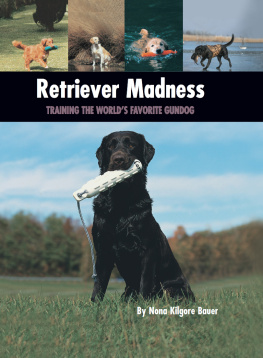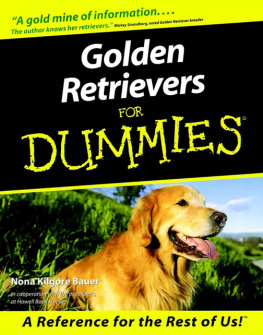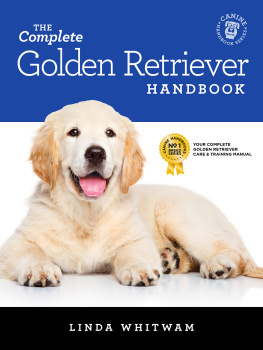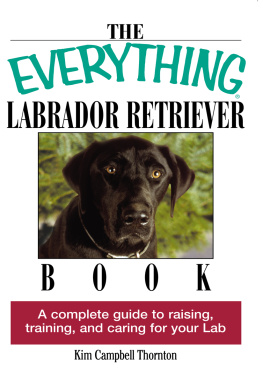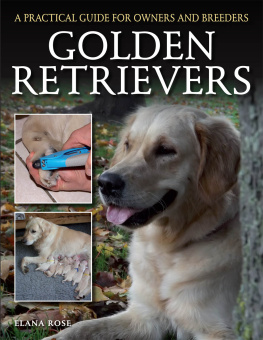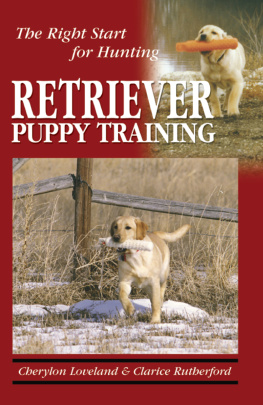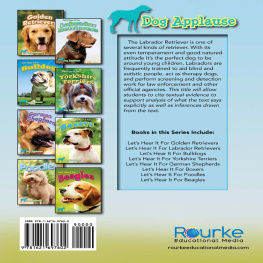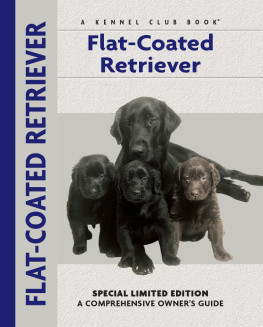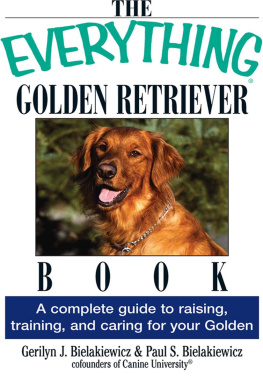EDITORIAL

Andrew DePrisco Editor-in-Chief
Amy Deputato Senior Editor
Jamie Quirk Editor
ART

Sherise Buhagiar Senior Graphic Artist
Bill Jonas Book Design
The publisher would like to thank the following photographers for their contributions to this book: David Dalton, Isabelle Francais, Carol Ann Johnson, Philippe Roca, and Alice van Kempen.
Cover photos by David Dalton, Isabelle Francais, Carol Ann Johnson, and Philippe Roca. Diagrams by Tom Kimball.
Kennel Club Books Country DogsTM Series
Retriever Madness
Copyright 2009

An Imprint of I-5 Press
A Division of I-5 Publishing, LLC
3 Burroughs, Irvine, CA 92618 USA
Library of Congress Cataloging-in-Publication Data
Bauer, Nona Kilgore.
Retriever madness / by Nona Kilgore Bauer.
p. cm. (Country dog series)
ISBN 978-1-59378-732-5
eISBN 978-1-59378-636-6
1. Retrievers. I. Title.
SF429.R4B38 2008
636.752735dc22
2008033758
All rights reserved. No part of this book may be reproduced, stored in a retrieval system or transmitted in any form or by any means, electronic, mechanical, photocopying, recording or otherwise, without the prior written permission of Kennel Club Books, except for the inclusion of brief quotations in an acknowledged review.
Printed and bound in China
16 15 14 13 12 11 10 2 3 4 5 6 7 8 9 10
Contents

Author Nona Kilgore Bauer and her beloved FC/AFC Chances R Mein Schatzie, taking home a field-trial blue ribbon.
Introduction
Some thirty-odd years ago, I watched in awe as an English-bred Golden Retriever named Jolly Again of Ouillmette come roaring back with his duck, both fur and feather flying. All-Age Qualified in field trials, Tuffy, as he was known, was never happier than when he was doing his bird thing. By golly, I wanted a dog like that!
To the hunting aficionado, there is perhaps no sight more thrilling than a retriever running at top speed with his mouth stuffed full of his prized bird. Be it duck, pheasant, or other plumaged fowl, you could swear that the dog is grinning behind all those feathers. Seeing the retriever doing the job that he was bred for is what hooked me on this dog sport.
That magical moment with Tuffy introduced me to this fascinating retriever game and to the field trialers, hunters, and trainers, amateur and professional alike, who compose the human aspect of this sport. These are talented people who are passionate about training their dogs and have been generous in sharing their knowledge with other dog nuts such as myself.
This book is intended to guide the novice owner through the basic baby steps of training a hunting retriever from puppyhood through his first year. I agree with the many experts who believeindeed have provedthat the foundation of a dogs success is based on the quality of his training and exposure during his first few months of life. Like a newborn infant, a puppy is born with a blank slate for a brain, possessing only whatever natural instincts he inherited from his ancestors.
In years past, training was delayed until a dog was at least six months old, but that delay failed to take advantage of the opportunity to imprint a puppys brain with positive experiences. We were told that a puppy was too young to learn his lessons and we should let him just be a pup before we filled his head with rules. In the process, he learned bad habits that would be difficult or even impossible to erase, and the owners failed to teach the pup the good habits he would need for proper house manners and any future breed-specific jobs. Like a sponge, his little brain was ready to soak up new information, but we let him develop into any dog.
Fortunately this philosophy has changed, and puppy-training methods also have evolved, with most using positive incentives and rewards.
To successfully train your dog, you must first understand how a puppy learns and realize that you cannot correct a pup for behavior he does not know is wrong. You must first teach him what you expect of him before you can scold him for not performing a specific task. This will take repetitionlots of itso the puppy can retain the information in his long-term memory.
What does all this have to do with teaching your retriever how to be a decent hunting dog? Without the right foundation, he will never reach his full potential as a hunting partner. A fair-to-middling hunter, probably, but he will not be the wow hunting dog your friends will gush about.
Beyond the basic training principles, well also review important early retrieving lessons as well as the yard work and typical drills used by professional trainers and experienced amateurs. As in our basic puppy training, well break all of this down into baby steps that you can understand and thus help your dog understand. After all, hes the one this book is all about.
This book is not meant to be the be-all and end-all source on teaching your retriever how to do his job. There are as many methods of and books on retriever training as there are trainersand thats a lot. As an adjunct to this book, you may want to consult friends who are experienced amateur trainers or seek out professional trainers to supplement the advice offered here. How far you go beyond these pages depends on what kind of hunting partner you desire. Remember, no matter to what level of proficiency you aspire, the time you spend (or dont spend) with your pup and the lessons he learns from you will determine how goodor greathe will grow up to be.
Before we begin, Id like to add a word on the electronic collar (ecollar) as a training tool. Almost every recently published book on retriever training includes information on how to condition and train dogs with e-collars. Professional trainers use the collars, as do the majority of experienced amateurs. Now employed in obedience training as well as in fieldwork, e-collars, when properly used, are efficient and effective training tools. In many cases, they are more humane and less stressful than the old-fashioned methods with nagging collar jerks and the even harsher methods using riding crops and cattle prods (oh yes, they did!).
However, the e-collar does not teach the dog what he is supposed to do. The dog must learn the behavior first; only then is the collar used to reinforce that knowledge. Timing of the electronic stimulation is critical and requires a skill that can be acquired only with time and experience, usually at the dogs expense while his novice owner is getting the hang of it. More important, one cannot dismiss the element of human angerthe handler/trainer gets upset with the dogs refusal to do what he thinks the dog should do, when in reality the dog is not properly conditioned or simply doesnt understand, and the dog is consequently shocked beyond all reason. Ive seen it happen far too many times, so I cant justify including a section on e-collar use knowing that even one person who reads this book might misuse the collar and abuse a dog.
For those interested in collar training, buy not one but several books that include detailed instructions on collar use, and find a seasoned amateur or professional to work with who is experienced with e-collars and whom you respect. When choosing that person, ask yourself whether his or her retrievers are happy, tail-wagging dogs who burst out of the truck or kennel with eagerness to go to work. If so, thats a good sign that the dogs have been properly conditioned and that they accept the collar as a fact of life. I hope you will find and learn from one of these trainers.
Next page
